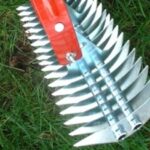With raised beds, gardens can be worked earlier, drainage is improved, weeding and harvesting is easier, and watering can be more efficient. Typically, raised beds allow you to plant selected crops in wide rows rather than single rows, which enables you to grow more vegetables in a smaller area. In an existing garden, raised beds can be created quite simply. If your garden is already tilled, you need only mark the dimensions of each bed and walkway. You will need stakes, string, a yardstick and a garden rake. The tops of each bed need to be narrow enough to allow you to comfortably reach the center of each bed, about 20 to 24 inches wide for most people.
If the beds are to extend north and south, start at the north end of the garden and drive a stake in the ground every three feet on the north side. Go to the south end and drive stakes every three feet there. Mark the center of each walkway by running string from one stake to the matching one on the other end of the garden. Try to stay off the tilled ground as much as possible when running the string. Start at the north end of the first walkway and use a garden rake to pull the soil toward you from the center of the second walkway (marked by a string) onto the existing soil in between the strings. You will be adding about 4 to 6 inches of soil onto the new bed. Since it has already been tilled, it doesn’t take a lot of strength or endurance to do this.
Move down the first walkway along the string, continually pulling up soil from the second walkway. You will soon have a pyramid-shaped bed. Move to the second walkway (stepping on the area cleared when creating the first bed), pull the soil from the first walkway onto the first bed, then turn around and pull the soil from half of the third walkway onto the second bed. Go to the third walkway, pull the soil from the other half of the second walkway onto the second bed, turnaround and pull the soil from the fourth walkway onto the third bed. When you have completed pulling the soil out of the walkways, go back to each bed and use the garden rake to flatten out the top of each bed. Each new bed will be about 16 to 18 inches wide.
If you flip the rake over and use the back side of it, the soil will smooth out quickly and evenly. This is also a good time to add fertilizer or compost to the soil if either one is needed. If you are starting a new garden and want to begin with raised beds, you’ll be putting out a little more effort. Once the area has been cleared of grass, you will mark the walkways in the same way as an existing garden. But instead of a garden rake, you will need a shovel. Dig out the walkways, and toss the soil on tops of the beds. Most likely, you will need to add compost and till or otherwise work the soil to prepare it for planting.
If you have the time, skills and money, you can build more elaborate raised beds by using landscape timbers, railroad ties, treated lumber or other materials. They are usually set on top of an area cleared of grass and requires that you haul soil in to fill them. This method is ideal for someone who wants only a small flower or vegetable garden. You will find that raised beds become warm earlier in the spring, which allows you to plant some crops earlier. Tomatoes, cucumbers and melons love warm soil. The soil doesn’t become compacted in raised beds so root crops (radishes, carrots, beets, etc.) will grow more easily because you are not stepping close to them like you do in rows. If your garden is too wet, drainage improves dramatically. Be watchful of crops in raised beds during a dry period however, they can dry out more quickly.
Building Raised Garden Beds
http://aggie-horticulture.tamu.edu/extension/raisedbed/index.html



